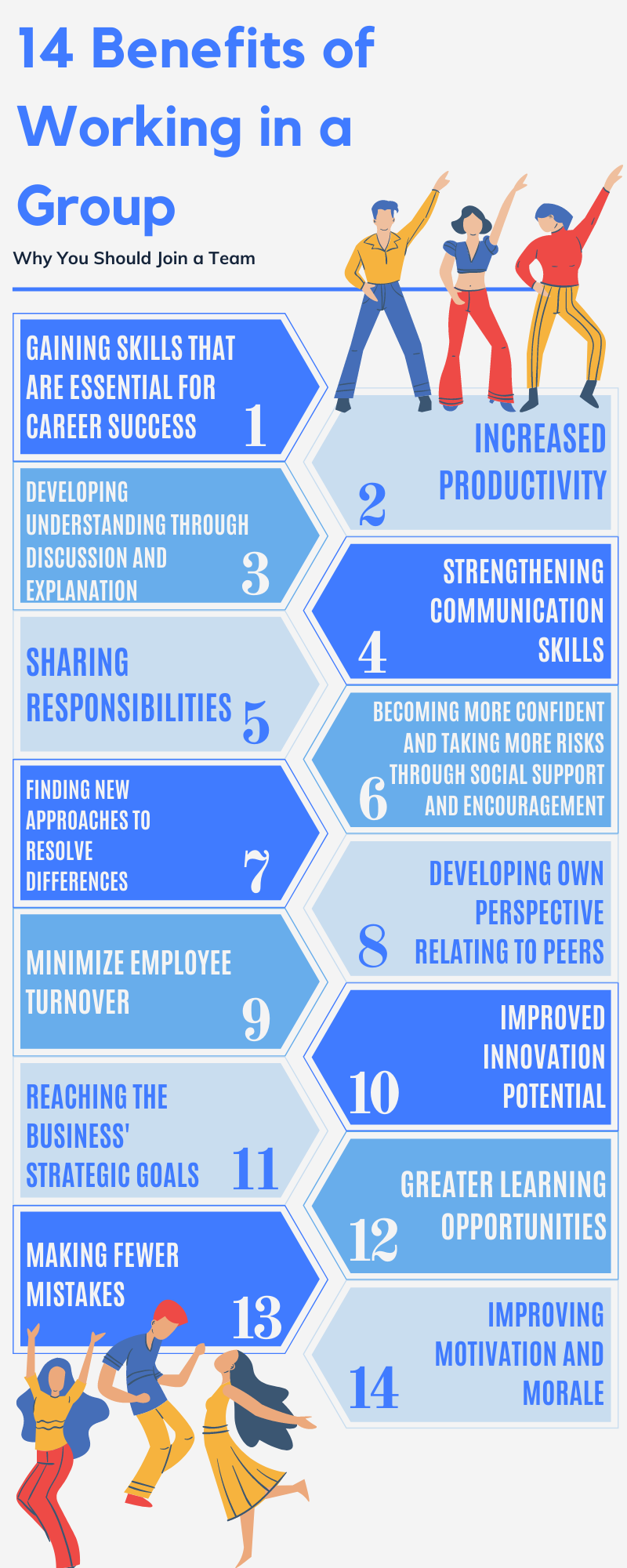There are numerous benefits of working in a group. Many great business leaders, like Simon Sinek, have stated that a great team is always preferable to a group of great employees.
Group work is important for many employees. Studies have found that three out of every four employees believe that teamwork is important. And teamwork has increased significantly, with more than 50% of tasks now collaborative.
Technology is very important for group work. Studies have shown that 83% of employees rely on technology for collaboration.
There are many ways that you can improve the skills for group work. These ways may include investing in new assets like technology from training on improving communications skills with employees.
Training and new technology can be an important part of the business’ budget. Several benefits for this can be seen from both the organization as well as by the employees.
In this article, we are looking at the 14 benefits that your organization and employees can experience.
1. Gaining skills that are essential for career success
Communication is one of the most important soft skills vital for employers. According to recruiters and career experts, communication is the most vital skill.
Communication isn’t just about communicating an idea to an audience. It is also important that staff learn how to listen. Listening can be a vital skill because it can provide key information that can help find solutions.
It isn’t just about communications though. Good communications need the right tools. This can help staff to learn new technologies that can help with other aspects of their work.
This has an added benefit for employees who then find themselves working in a better environment. For instance, staff in an environment with good communications will experience:
- High levels of trust between team members.
- Improvement in problem-solving.
- A better way for staff members to deal with conflict.
Good communications can be a great way for employees to find new career opportunities and growth. Therefore, staff can feel more secure and more satisfied in their position.
2. Increased productivity
Working as a team, in collaboration, has been proven to help businesses improve their productivity.
- Businesses are losing about £25,000 a year per employee from bad communication skills in the UK.
- More than 86% of executives report that inefficient communication is one of the major factors affecting productivity.
- When employees are offered better communication technology and skills, productivity can increase by up to 30%.
- Staff who are in collaboration with others stick with their tasks for 64% longer.
Productivity is increased through many different avenues.
First of all, conflict resolution is improved and misunderstandings are reduced. These two areas can be significant barriers to good working practices and can prevent a business from working steadily through a project.
Another benefit is that better communication allows workers not to be confused by the instructions given to them. Therefore, there is less wastage of time and resources that would otherwise have to be discarded.
Another avenue of improvement is through better sharing of responsibilities where staff can delegate tasks. This allows for the best person to take on a process. And therefore the quality of work can also be increased.
3. Developing understanding through discussion and explanation
Good communication is the foundation of an effective team environment. With better communication tools and the improved skills of staff, your teams will be able to discuss more work and potential conflicts.
As a result, you can be sure that team members can look for solutions to potential problems quickly. This prevents your teams from being bottle-necked in production and prevents teams from wasting time.
In addition, it can prevent conflicts that can be harmful to relationships and stop work in progress. Research has found that 2.8 million hours a week are wasted in conflict, which simple communication skills and new technologies to improve teamwork can solve.
You’ll also find that a better understanding of ideas and concepts can help to find new opportunities. This can help with business growth as leaders and employees see avenues that can lead to cost savings or new revenue options for the business.
4. Strengthening communication skills
Communication skills are one of the cornerstones of good group work. They are important for transferring ideas, concepts, and more. Not only do corporations benefit from this, but employees will also benefit.
It is important to note that employees don’t just need to improve how they talk to others. Between 70 and 93% of all communications are through non-verbal methods. This can be much more important when you’re using technology too.
Simple emails can often be misunderstood. Through simple training and technology, communication skills can be significantly improved. Then non-verbal communication traits can also be improved for better results when interacting with others.
Staff with better communication skills become better leaders too. Whether they are a leader by position or someone in the office who is an influencer, you should utilize their skills to influence others to complete tasks that you need to complete for a better working environment and business goals.
5. Sharing responsibilities
A job shared is a job made easier. And better group work allows for teams to divide a series of tasks together to complete projects quicker and to a higher standard. The key issue here is for everyone to realize their strengths, communicate those and for a discussion to decide on who should do what task.
Then teams can split to complete their different aspects with ease.
When completed, the team can come back together to talk about their respective parts of the task, seek advice/support/feedback and then divide the next series of tasks.
Sharing responsibilities can be a great way for your business team members to find satisfaction in their work. They aren’t doing the tasks that they’re not enjoying, completing tasks that they feel are more suited for them, and then improving the output of the work they’re completing.
You might find that you are also able to find mini-teams that are within your larger pool of employees who can complete work better together.
And by giving different members of your team their responsibilities, you’re improving job satisfaction as they feel part of a shared goal.
You can also use tools like Helpwise that allow you to automatically delegate and assign emails to different team members in a shared inbox. You can then use features like reports to track KPIs and team member performance.
6. Becoming more confident and taking more risks through social support and encouragement
One of the biggest factors that prevent growth within a business is fear. Staff might fear many things but the biggest barrier is fear of them being able to complete new or harder tasks. That is why working in a group environment can be very important.
Team members can encourage each other by providing honest feedback. This can be a great way for staff to find more confidence and therefore they are willing to take more risks.
Encouragement can also be a great way for staff to have higher levels of motivation that can help with productivity improvements.
And the positive experiences that staff will have will help with retention. Staff losses can be one of the biggest costs that a business can get, but simple social support and encouragement can, as a result, give staff more of a reason to stay.
The financial cost for each saved recruitment can be as much as $4,129 per recruited employee. And this does not include the costs of lost production from having to get new employees fully productive, which can take up to 18 months.
You will also find that staff will be willing to take more financially-benefiting risks with their work. This is to seek out new opportunities for growth and revenue. Therefore, businesses can see higher levels of return.
7. Finding new approaches to resolve differences
When employees aren’t working together they are usually stuck on working on a problem with a set of known solutions. These solutions, while working in the past, might not work with a new scenario.
Using a team environment, colleagues can bounce ideas off each other. Therefore, they can create new ideas for working solutions to problems that have appeared.
Ideas that are formulated can be new ideas to certain team members or they can be hybrid solutions between different people.
And this doesn’t just relate to challenging tasks. Resolving differences through communications can result from the personal differences that occur between team members. There are going to be times when there is interpersonal conflict, but working as a team can create new bonds that overcome this.
You will also find that as a result, the new approaches might see cost-saving benefits for the organization that provides higher levels of profit. You might also notice that your business discovers new products/services that can be offered that are ways to grow for the organization.
8. Developing own perspective relating to peers
One of the biggest challenges to resolving conflict within an environment, whether it is the work or personal space, is the perspective or opinion of the person. Communication and working together as a team can help people to see the opinion of others with ease.
This can help them with developing an understanding that can help people to find new solutions to interpersonal problems.
Within customer service environments, this can be a great source of power. A team that works together can help support each other in understanding the viewpoints of not just other team members, but the customers.
Therefore, your team can approach the concerns of customers with more empathy and this can lead to a better experience for customers. Customers who are happier with the service that they have had with you will be more likely to shop with you again. And returning customers spend more on future purchases.
9. Minimize employee turnover
About a third of employees report that they are not given enough of an opportunity to work with others. This makes them feel isolated and depressed at work. As a result, many of these employees are looking for new work.
Employees leaving your business are a large cost to human resources. Not only are you losing their skills, but you’re gaining costs that could be avoided. The costs for each employee leaving are:
- Averaging at just over $4,000.
- Some high-level employees can cost up to 6 months’ worth of a salary
- Productivity is lower for new employees for up to six months after hiring.
It is also important to note that about 50% of new hires are considered poor choices. They can often leave before they start earning the organization a positive return and they can also disrupt current workplace dynamics and company culture.
By utilizing a more social environment where employees are encouraged to work as a team through interpersonal connections and technology, you can retain more staff.
10. Improved innovation potential
If you’re looking for an environment where you’re going to find a new process to complete tasks then team working is essential. Research by the Harvard Business School has found that small teams are more likely to find ways to grow an organization.
They can combine ideas, experiences, and skills that create a unique dynamic to face solutions that one person cannot.
But for this to work, team members need to feel comfortable in the environments and look for ways that they can communicate freely.
That is why using technology is so important for the business and any current project management work. Small groups of employees communicating over VoIP software are often more willing to share ideas and experiences than in a group. This is because online communications tend to make individuals who would usually dominate to be unable to do that.
Innovation can also help you to find new ways to earn revenue or reduce costs. For instance, small groups might be able to spot new trends in the market that allow you to make changes in your marketing approach or how you offer customer service.
Another option is that small groups might discover that customers are looking for a new solution that is not on offer. However, they might realize together that something you already have can be adapted to suit the needs of the customer.
11. Reaching the business’ strategic goals
Communication is essential if you’re looking to reach strategic goals for the business. Social psychology studies have found that better communications and group work can allow for a larger, more thorough understanding of the goals set but also why the leadership team is trying to achieve them.
If team members understand the need and the why of a business goal, then they are more likely to accept them and try to achieve them. This can improve overall group performance as well.
You will also find that group work allows you to find better ways to monitor the progress towards that goal. Leaders will see what progress has been made and see what barriers have been found. Then teams can work together on ways to reduce those barriers and overcome them.
This allows your business to find reaching your business strategic goals much easier and quicker.
- About 67% of businesses don’t even achieve business goals.
- Group work can improve the chances of success.
- Group work can reduce business costs by up to £10 million a year.
You will notice that when, as a team, you reach the business’ strategic goals the team will feel happier as they feel the sense of achievement.
12. Greater learning opportunities
Learning is one of the most important aspects of job satisfaction. If employees feel that they’re in a working environment that allows for career progression and skill development, they are more likely to stay.
The benefit of group work is that you can have a collaboration of experts who can learn from each other. Each group member will have something that they can give to the other team members. Whether this is skills for new computers systems, communications skills, or how to work with software or equipment.
Great learning opportunities will feed directly into improved performance across all areas of your business. They can improve the speed at which they will complete tasks, they can also improve accuracy.
Learning within the team environment will also allow for the work to be completed to a unified standard. So it doesn’t matter who on your team does the work, the finished task would be the same. This can keep customer satisfaction high too.
Another benefit of greater learning opportunities is that you no longer have to recruit outside of the business to find new leaders. You can recruit from inside your team. This has several benefits for your business.
For instance, recruiting internally allows you to bring in more junior members of the team as replacements instead, which are cheaper. It also means new leaders are those who are already familiar with the brand’s core ethics and values.
13. Making fewer mistakes
When it comes to wastage within a business, this is often from mistakes that are made by team members who are not working in groups. This is because there is no one there who can act as a backup and check work when it is done.
Mistakes don’t just cost businesses wasted resources. They can cost a lot of money when the work has to be redone or some consequences take more time and money to repair the damage.
In addition, mistakes can also cost your company customers. Customers can be very hard to replace. It costs more to acquire new customers than to convert existing customers.
You will also find that customers are not likely to return to a brand if they’ve had a negative experience.
While checking for mistakes, however, it is important that staff feel secure. The feedback that is not given back in a friendly and constructive manner can sometimes be upsetting for employees and this can cause resentment.
However, when working in a group, when mistakes are made, the whole team can learn from the issues. These can become important training lessons that can reduce the mistake from happening in the future as well.
14. Improving motivation and morale
Humans, by nature, are social. They like to feel like they are part of a community. Therefore, when they are not working in a group, they can often feel isolated. This can have severe problems to the employee’s productivity and motivation at work.
Motivation at work is vitally important. Without it, staff can often be more absent from work. This can cause lost productivity. Research has found that the cost of lost productivity from absent hourly employees is $3,600 per year and $2,660 per year for salaried employees.
At the same time, those with low motivation are more likely to move jobs. This can have a serious impact on funds as new team members and their induction will have to be paid for. You will also lose the skills and experience of that team member.
You will also find that when team members are not motivated, you might get bad employee reviews on employment websites. This can cause significant problems when it comes to recruiting new team members as those who read these will be reluctant to join a company with a bad reputation.
Conclusion
Working in a team is an important part of any organizational process. Team working allows a business to find great opportunities for growth and innovation. At the same time, with the right technology, teams can be more productive and more cost-effective.
So, start to use more teamwork in your organization to start your business’ improvement. As soon as your employees start to work in groups, they will feel happier, be more productive, and have higher levels of job satisfaction.
As a result, you can be sure that your organization will see lower costs in recruitment as well as an increase of up to 30% in revenues.










